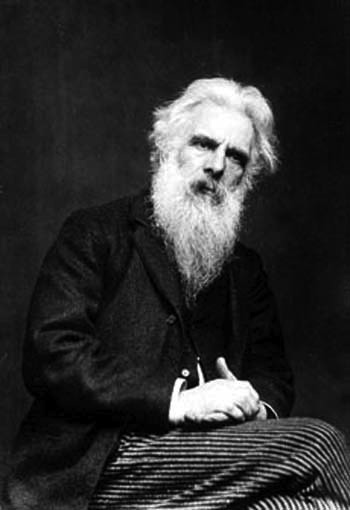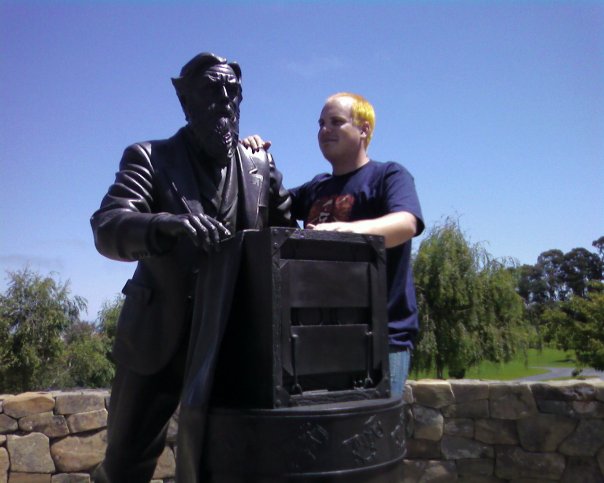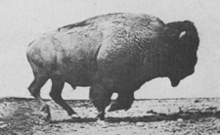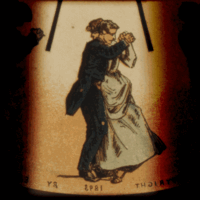<Back to Index>
- Physicist Thomas Johann Seebeck, 1770
- Photographer Eadweard James Muybridge, 1830
- King of the Belgians Leopold II, 1835


Eadweard J. Muybridge (9 April 1830 – 8 May 1904) was an English photographer who spent much of his life in the United States. He is known primarily for his important pioneering work on animal locomotion, with use of multiple cameras to capture motion, and his zoopraxiscope, a device for projecting motion pictures that pre-dated the flexible perforated film strip that is used today.
Muybridge was born Edward James Muggeridge at Kingston upon Thames, London, England. He is believed to have changed his first name to match that of King Eadweard as shown on the plinth of the Kingston coronation stone, which was re-erected in Kingston in 1850. Although he did not change his first name until the 1870s, he changed his surname to Muygridge early in his San Francisco career and then changed it again to Muybridge at the launch of his photographic career or during the years between.
In 1855
Muybridge arrived in San Francisco, starting his career as a
publisher's agent and bookseller. He left San Francisco at the end of
that decade, and after a stagecoach accident in which he received
severe head injuries returned to England for a few years.
He reappeared in San Francisco in 1866 as a photographer named Muybridge and rapidly became successful in the profession, focusing principally on landscape and architectural subjects, although his business cards also advertised his services for portraiture. His photographs were sold by various photographic entrepreneurs on Montgomery Street (most notably the firm of Bradley & Rulofson), San Francisco's main commercial street, during those years.
Muybridge began to build his reputation in 1867 with photos of Yosemite and San Francisco (many of the Yosemite photographs reproduced the same scenes taken by Carleton Watkins). Muybridge quickly gained notice for his landscape photographs, which showed the grandeur and expansiveness of the West. The images were published under the pseudonym “Helios.” In the summer of 1868 Muybridge was commissioned to photograph one of the U.S. Army's expeditions.
In
1872,
former Governor
of
California Leland
Stanford, a businessman and racehorse owner,
had
taken a position on a popularly debated question of the day:
whether all four of a horse's hooves left the ground at the same time
during a gallop. Stanford sided with this assertion, called
"unsupported transit", and took it upon himself to prove it
scientifically. Stanford sought out Muybridge and hired him to settle
the question. In 1877,
Muybridge settled Stanford's question with a single photographic
negative showing Stanford's racehorse Occident airborne in the midst of a
gallop. This negative was lost, but it survives through woodcuts made
at the time. By 1878, spurred on by Stanford to expand the experiment,
Muybridge had successfully photographed a horse in fast motion. This
series of photos taken in Palo
Alto,
California, is called Sallie
Gardner
at a Gallop or The
Horse
in Motion, and shows that the hooves do
all
leave the ground — although not with the legs fully extended
forward and back, as contemporary illustrators tended to imagine, but
rather at the moment when all the hooves are tucked under the horse as
it switches from "pulling" with the front legs to "pushing" with the
back legs.
Eventually,
Muybridge
and Stanford had a major falling-out concerning this research
on equine locomotion: Stanford published a book The Horse in Motion which gave no credit to
Muybridge despite containing his photos and his research, possibly
because Muybridge lacked an established reputation in the scientific
community. As a result of Muybridge's lack of credit for the work, the Royal
Society withdrew an
offer to fund his stop-motion photography. Muybridge subsequently filed
a lawsuit against Stanford, and lost. In 1874,
still living in the San Francisco Bay Area, Muybridge discovered that
his wife had a lover, a Major Harry Larkyns. On 17 October 1874, he
sought out Larkyns; said, "Good evening, Major, my name is Muybridge
and here is the answer to the letter you sent my wife"; he then killed
the Major with a gunshot.
Muybridge
believed Larkyns to be his son's true father, although as an adult, the
son bore a remarkable resemblance to Muybridge. Muybridge was put on
trial for murder, but was acquitted as a "justifiable
homicide". The inquiry interrupted his horse photography
experiment, but not his relationship with Stanford, who paid for his
criminal defense. An
interesting aspect of Muybridge's defense was a plea of insanity due to
a head injury Muybridge sustained following his stagecoach accident.
Friends testified that the accident dramatically changed Muybridge's
personality from genial and pleasant to unstable and erratic. The jury
dismissed the insanity plea. After
the
acquittal, Muybridge left the United States for a time to take
photographs in Central America, returning in 1877. He had his son,
Florado Helios Muybridge (nicknamed "Floddie" by friends), put in an
orphanage. As an adult, Floddie worked as a ranch hand and gardener. In
1944 he was hit by a car in Sacramento and killed. This
episode in Muybridge's life is the subject of The
Photographer, a 1982 opera by Philip
Glass, with words drawn from the trial and Muybridge's letters to
his wife.
At
the
Chicago 1893 World's
Columbian
Exposition, Muybridge gave a series of lectures on the
Science of Animal Locomotion in the Zoopraxographical Hall, built
specially for that purpose in the "Midway Plaisance" arm of the
exposition. He used his zoopraxiscope to show his moving
pictures to a
paying public making the Hall the very first commercial movie theater. At the
University of Pennsylvania and the local zoo Muybridge used banks of
cameras to photograph people and animals to study their movement. The
models, either entirely nude or with very little clothing, were
photographed in a variety of undertakings, ranging from boxing, to
walking down stairs, to throwing water over one another and carrying
buckets of water. Between 1883 and 1886 he made a total of 100,000
images, working under the auspices of the University of Pennsylvania.
They were published as 781 plates comprising 20,000 of the photographs
in a collection titled Animal Locomotion. Muybridge's work stands
near the beginning of the science of biomechanics and the mechanics of
athletics. Recent
scholarship has pointed to the influence of Étienne
Jules
de Marey on
Muybridge's later work. Muybridge visited Marey's studio in France and
saw Marey's stop-motion studies before returning to the U.S. to further
his own work in the same area. However, whereas Marey's scientific
achievements in the realms of cardiology and aerodynamics (as well as
pioneering work in photography and chronophotography) are indisputable,
Muybridge's efforts were to some degree artistic rather than
scientific. As Muybridge himself explained, in some of his published
sequences he substituted images where exposures failed, in order to
illustrate a representative movement (rather than producing a strictly
scientific recording of a particular sequence). Similar
setups of carefully timed multiple cameras are used in modern special
effects photography with
the
opposite goal of capturing changing camera angles with little or no
movement of the subject. This is often dubbed "bullet
time" photography.
Eadweard
Muybridge
returned to his native England in 1894, published two
further, popular books of his work, and died on 8 May 1904 in Kingston
upon
Thames while
living at the home of his cousin Catherine Smith, Park View, 2
Liverpool Road. The house has a British Film
Institute commemorative plaque on the outside wall. Muybridge
was cremated and his ashes interred at Woking.
Many
of
his photographic sequences have been published since the 1950s as
artists' reference books. In 1985 the music
video for Larry Gowan's single "(You're A) Strange Animal" prominently featured
animation rotoscoped from Muybridge's work. In
1986 the galloping horse sequence was used in the background of the John
Farnham music video
for the song Pressure
Down. In 1993, U2 made a video to their song "Lemon"
into
a tribute to Muybridge's techniques. In 2004, the electronic music
group The
Crystal
Method made a music video to their song "Born Too Slow" which was based on
Muybridge's work, including a man walking in front of a background grid. A
documentary of his life and work, titled Eadweard
Muybridge,
Zoopraxographer was
made
by filmmaker Thom
Andersen, in 1974.
Composer Philip
Glass's 1982 opera The
Photographer is
based on Muybridge's murder trial, the libretto including text from the
transcript. A promotional music video of an excerpt of the opera
dramatized the murder and trial and included a considerable number of Muybridge images. Kingston
University, London, UK has a building named in recognition of his
work as one of Britain's most influential photographers. In 2007,
Canadian poet Rob
Winger wrote Muybridge's Horse: a
poem in three phases, a long poem nominated for the Governor
General's
Award for Literature, Trillium
Book
Award for Poetry, and Ottawa
Book
Award. It documented his life and obsessions in a
'poetic-photographic' style. It won the CBC
Literary
Award for Poetry.

